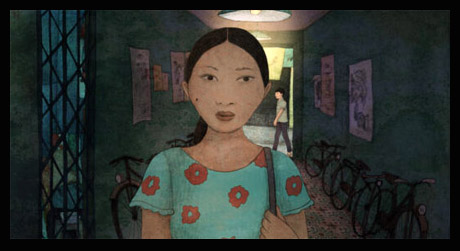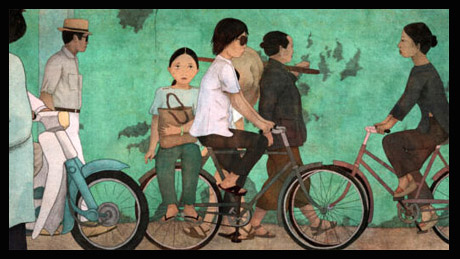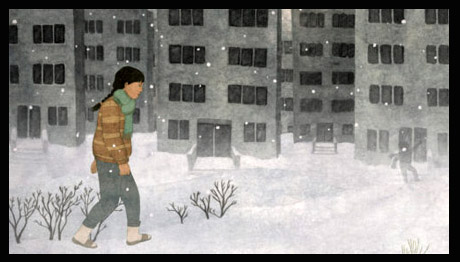
As Animation Scoop continues its in-depth look at all 15 of this year’s Best Animated Short Film Oscar finalists, the spotlight now shines on Flowing Home, a drama from director Sandra Desmazières. In this Email Q&A, Desmazières explains the significance of her short and how its story and visuals will impact audiences.
Jackson Murphy: What appealed to you about telling a story set during this period of time?
Sandra Desmazières: It’s an important period to me. My parents met in Vietnam during the war. My father is French and my mother is Vietnamese. She left Vietnam before Saigon fell in 1975, and a few years later her brother joined us in Paris. The first time I went to Vietnam, with my sister and mother, was in 1997. I had wanted to tell a story set in that period for quite some time. To talk about separation, leaving one’s country, family, memories that can haunt us like ghosts.

JM: Why is writing a letter to a loved one so important?
SD: When I was young, in our house there was a drawer full of all these letters from Vietnam. It was the only link to a family and a country that I didn’t know. I didn’t know what was written in the letters; we didn’t talk about the past, or the war, or about sad things. My sister and I grew up with that past without really understanding, so we would imagine all sorts of things. The letters stand in for someone who isn’t there; for the absent and the dead. To deal with the silence, the absence and all the things they couldn’t say to each other, the exchange of letters between Sao Mai and Thao is like a conversation they could have started when they were separated in 1978 and that wouldn’t end until they were reunited 20 years later.

Sandra Desmazieres
SD: My sister and I are very close. We’re only a year apart and we see each other all the time. Her house is barely a three-minute walk from mine. We don’t have exactly the same memories or see things exactly the same way, but we complement each other. I tried to show that duality, as well as that bond that sisters can have. I’m thinking of the first shot in the film, for example, where Thao and Sao Mai listen to their parents talking through the door: they understand that they will have to part. Without looking at each other, without a word, with a simple gesture, they convey to the audience that each knows what the other is feeling. I tried to imagine how I would feel if I had to be separated from her for 20 years.
JM: How did you want to show the pain that war can bring?
SD: I didn’t especially want to show pain. I didn’t live through that time, because I was born in 1978, and for me the idea of addressing that subject was touchy. All war stories are painful. What I did want to show was what I saw in my own family, and in the stories of my friends who came from Vietnam. We were met with silence when we asked questions about those years. I grew up with many things left unsaid, but what I perceived in them was pain, sadness, the violence of feelings, and a need to bury everything so as not to remember it. I tried to show all that, for example with the voiceovers, which I consistently intended to be restrained and reserved, in keeping with the sisters’ lack of physical contact and their isolation.

JM: How did you want to challenge yourself and your artistic style with the animation in this short?
SD: The film covers a long period, from the early 1970s to the late 1990s, with a lot of characters. Unlike my other films, this one is almost a documentary. Guerric Catala, the editor, found solutions in the editing: we had to recount a long period of time in 15 minutes, flashing back and returning to the present and giving the viewer just enough information to guide them and have them engage with the sisters’ story via only picture and sound, all while making sure the narration still flowed. Manuel Merlot’s music enables those jumps in time and takes us into the past with a sense of melancholy. I normally work alone, but on this film, we had a small team. Part of the animation was done on paper here in France and part of it in Canada, using TVPaint. Janet Perlman found the tools to recreate the lines and shading of pencil on paper. On trips to Vietnam, we recorded sounds, took photos and sketched. I drew inspiration from the colors of the landscapes, the green walls of the houses, the tiles that you typically see on the ground. I tried to recreate the atmosphere that I’d kept in my mind, using textures, paint and pastel colors… and I took inspiration from family and archival photos as well. The more research I did, the more realistic my drawing became!
JM: There’s a very cool moment involving jellyfish. How did you create that?
SD: The crossing by boat was very long and dangerous. After the scene with the storm and when they find the child lying dead on the deck of the boat, I wanted to have a break, a moment to breathe. A friend, who was five years old when he was forced to flee Vietnam, shared his memories with me. He remembered an arduous journey, but also that he had played on the boat, and saw flying fish, and thought that was just wonderful. I wanted to mark the end of the crossing with moments seen through a child’s eyes, almost phantasmagoric moments, with these phosphorescent jellyfish illuminating the ocean floor and the flying fish, and finally landfall.

JM: How has illustrating children’s books impacted your animated short films?
SD: I think the two have influenced each other. The characters in my films often resemble the protagonists of the books I’ve illustrated. For example, June et Léa, by Sandrine Bonini, tells the story of two sisters who are very close, almost twins, and how they’re separated as teenagers and come together again at the end. The way I drew those sisters is very close to Thao and Sao Mai, although the technique differed. The book illustrations were done in oil paint on rice paper. I often draw in landscape format, so that’s something I’ve also wanted to apply in my films, with long takes and lateral camera movements. When I draw or paint, I really like using oil paints and grease pencils, using the transparency of these media to bring more depth to the drawing. I try to work the same graphic rendering into my animation, blending textures of painted colors, for example, and superimposing different materials to play with transparency.
JM: How do you feel about this Oscar shortlist recognition, and what would being an Academy Award nominee mean to you?
SD: It’s nuts! And to be nominated would be even crazier.
- INTERVIEW: Jeff Fowler On “Knuckles” And “Sonic 3” - April 22, 2024
- INTERVIEW: “Inside Out 2” Director And Producer On Pixar Sequel - April 16, 2024
- INTERVIEW: “Puffin Rock And The New Friends” And 25 Years Of Cartoon Saloon - April 10, 2024


 January 7th, 2022
January 7th, 2022  Jackson Murphy
Jackson Murphy  Posted in
Posted in  Tags:
Tags: 






